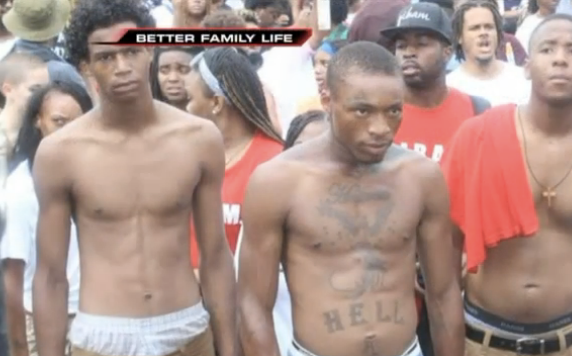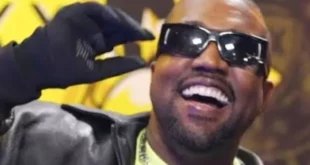Stuff Black People Don’t Like
September 5, 2014
Why do police stop so many black people in St. Louis?
We’ve already established, via analyzing the City of St. Louis Metropolitan Police Department Annual Report to the Community (from 1999-2013), that the black population of the city is responsible for virtually all the homicides.

Mind you, the city of St. Louis is 49 percent black and 43 percent white.
So when the black newspaper in the city of St. Louis, the St. Louis American, reports about some sort of “gun crisis” please automatically understand it has nothing to do with white people. [‘Gun Violence is a Crisis’, St. Louis American, 6-20-13]:
Children and adults gathered on the steps of St. Louis City Hall last Friday to remember Sandy Hook Elementary victims and to ask legislators to push for more rigorous gun-control laws.
The candlelight vigil was part of a national movement, yet it couldn’t have been more timely for St. Louis. On June 10, 17 people were injured in gun violence during seven different incidents all in one night. Four days later, four people were shot and killed in a murder-suicide at a Cherokee Street business.
“The amount of gun violence is a crisis,” said 21st Ward Alderman Antonio French, who spoke at the candlelight vigil. “It needs to be a treated as crisis. It’s an emergency situation.”
Every year, the majority of murder victims in the St. Louis region are young African-American men.
“Gun violence is a leading cause of death among some groups in our community,” French said.
James Clark, vice president of community outreach for the nonprofit Better Family Life, was not surprised to hear about 17 people being shot in one night.
“What disappoints me is our apathetic response as a community,” he said.
When a white cop shoots an ‘unarmed’ black “gentle giant,” the apathy and indifference of the black community in metropolitan St. Louis is replaced with righteous indignation.
Remember though: hypothetically speaking, without a black population, the metropolitan St. Louis region would be virtually free of gun crime and have a homicide rate approaching… well, it would so small as to represent a statistical anomaly.
Gun violence will always be a problem in the black community, because these communities are full of black people. No matter if the National Association for the Advancement of Colored People (NAACP), the St. Louis Clergy Coalition’s law and order committee, the St. Louis Initiative to Reduce Violent Crime, the Put Down Your Pistol campaign, Better Family Life, the St. Louis County chapter of the National Urban League, or churches of various disciplines intervene, the gun violence will persist. [Groups want end to St. Louis gun violence, St. Louis Post-Dispatch, 8-6-12] Remember, the formula for Baltimore’s condition in 2014, Low Impulse Control + Poor Future Time-Orientation + Low IQ(x)Jury Nullification (black political control)², also helps explain the city of St. Louis’ state.
Even when you factor in all the time and effort from scores of private organizations/foundations (funded with grants from both private and private organizations/institutions), black-in-origin gun crime/violence doesn’t subside.
Which brings us to the point of this whole exercise in considering this hypothetical: if there were no black people in the St. Louis metropolitan region, would there be any fatal police shootings? Consulting research by University of Missouri-St. Louis Criminologist David Klinger, the answer is ‘no’. [Diverse police forces are not a panacea for fatal police shootings, St. Louis Post-Dispatch, 9-3-14]:
Amid the firestorm of protests following the shooting of Michael Brown — an unarmed black teen who was killed by a white police officer — have come repeated calls for hiring a more diverse police force. But a growing body of research suggests that intractable circumstances of economics, culture and geography have more to do with shootings by police than the race of the officers.
According to the research, neglected minority neighborhoods that are poor and prone to violence are a hotbed for such shootings — regardless of the complexion of the police. David Klinger, and other criminologists at the University of Missouri-St. Louis, including Isom, wrote an academic paper about 230 shooting incidents involving 315 St. Louis police officers between 2003 and 2012. Of those, about two-thirds of the shooters were white and one-third were African-American. According to the paper, the distribution was reflective of the police department during that period.
Of the known suspects police were shooting at in those cases, 92 percent of them were African-American. St. Louis is 49 percent black. According to St. Louis police data for 2012 and 2013, 94 homicide suspects were African-American; two were white; one was Hispanic; and one was Asian. Of 4,713 inmates sentenced in St. Louis who are in state prison, 598 are white and 4,083 are black.
And to think: St. Louis is situated near to the very heart of the contiguous United States of America.
More to the point: the violence found almost exclusively courtesy of black individuals (byproducts of the black community) in St. Louis, is routinely over something as trivial as “an outstanding drug debt worth about $20 to $40.”[Residents on Thrush Avenue look for safety from shootings, St. Louis Post-Dispatch, 7-26-14]:
In the wake of back-to-back shootings that killed one person and injured three others recently, residents in the 700 block of Thrush Avenue are understandably on edge.
There is a sense that retaliation is coming.
“It’s like something spiritual, something I can feel,” said Venus Houston, 38, from her front porch. “It’s heavy.”
During the day, she and others on the block seem to watch every vehicle that turns onto the dead-end street in the Baden neighborhood in St. Louis, hoping to catch a glimpse of a familiar face behind the wheel, not another shooter.
Thursday evening, after darkness fell, Houston searched for friendly headlights.
She hoped it was her ride out of there for the night.
Too many in the family to stick together, three of her children, a sister and young nieces who live with her had already departed for havens, a recent regular routine to escape the threat of violence. Houston and her 7-year-old son, Elijah, were going to be the last to go.
Their ride was running behind.
“It has been inconvenient because for the most part we haven’t been sleeping here,” Houston said of the shootings.
Drug Infested
A worn sign on North Broadway speaks to the days when this was a German neighborhood: “Danke schoen for visiting Baden.”
“The majority of people are good, hard-working,” said the Rev. Don Buhr, of nearby Our Lady of the Holy Cross Catholic Church. “Many are unemployed. Not because they are unwilling. It’s just there are no jobs.”
Where one street is calm, another is rough.
“It’s definitely infested,” Buhr said. “Anybody who is on drugs, keep away from them.”
Crime in Baden has been declining over the years, according to city police statistics.
The rate is above that of the city as a whole, but ranks below a couple dozen other neighborhoods.
A vast majority of the area’s crime, like in many parts of the city, is related to burglary, larceny, robbery and vehicle thefts. Between 2000 and 2010, the area lost 14 percent of its residents, according to U.S. Census statistics.
When Dana Stiebel started buying property around Baden Avenue about 10 years ago, she said it was like a McDonald’s drive-in for drugs and prostitution. She said she is known as a no-nonsense landlord.
“None of these people, if you look at them, are angels,” she said. “That’s not who lives here.”
There are no jobs in this area, because the risk/reward for an investor (owner of capital) to open a business in this formerly German community is 100 percent considered a “risk” of unimaginable proportions.

Once where Germans built a community in this landmass located in metropolitan St. Louis, now the black inhabitants create conditions where no business can flourish.
It’s simply a hypothetical, but if this area was still inhabited by German’s, would the St. Louis Post-Dispatch write melancholy stories of the woeful state of all-black areas of St. Louis in an attempt to induce white guilt?
No.
Because this community is drug-infested and filled with criminality (with shootings and homicides over drug debts of $20 to $40 dollars) courtesy of its black inhabitants.
Just as St. Louis and the suburbs surrounding the city would have virtually no homicides or gun violence without (hypothetically speaking, of course) its black population.
Just as police would be nothing more than glorified babysitters (occasionally putting out an A.B.P. for white teenagers who dared to toilet paper a neighbors house) were the city and metropolitan – hypothetically – without a black population.
Instead, nearly all police shootings involve a black suspect…
And because the black population of St. Louis and the city’s suburbs are unable to produce the same quality of life as their white counterparts, organizations such as the National Association for the Advancement of Colored People (NAACP), the St. Louis Clergy Coalition’s law and order committee, the St. Louis Initiative to Reduce Violent Crime, the Put Down Your Pistol campaign, Better Family Life, and the St. Louis County chapter of the National Urban League must exist to lobby exclusively on their behalf.
Hypothetically speaking, of course, but do you begin to understand what St. Louis would be like if there were only white people? :
- The swift execution of criminals convicted of murder or rape, with no organizations existing on their behalf to label such judicial actions as “racist” or whine over “social justice”
- Police allowed to do their job, instead of being fearful over every encounter with a black male suspect (believing their job, pension, or life might be at stake if the interaction leads to a “civil rights” inquiry), knowing an “Officer Darren Wilson Scenario” could occur on any given shift…
- The end of “white flight” because white people would have no reason to abandon a city like Ferguson, that went from 99 percent white in 1970 to 27 percent white today (less than.1 percent black in 1970 to 67 percent black today)
- The establishment of communities (where roots could be established, multiple generations of families could live, work and build), free of drugs and petty violence over a $20 dollar drug debt that leaves cars and houses riddled with bullets…
 Daily Stormer The Most Censored Publication in History
Daily Stormer The Most Censored Publication in History


